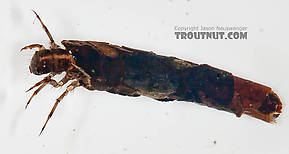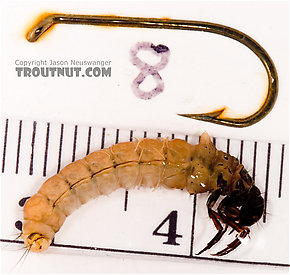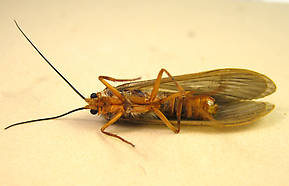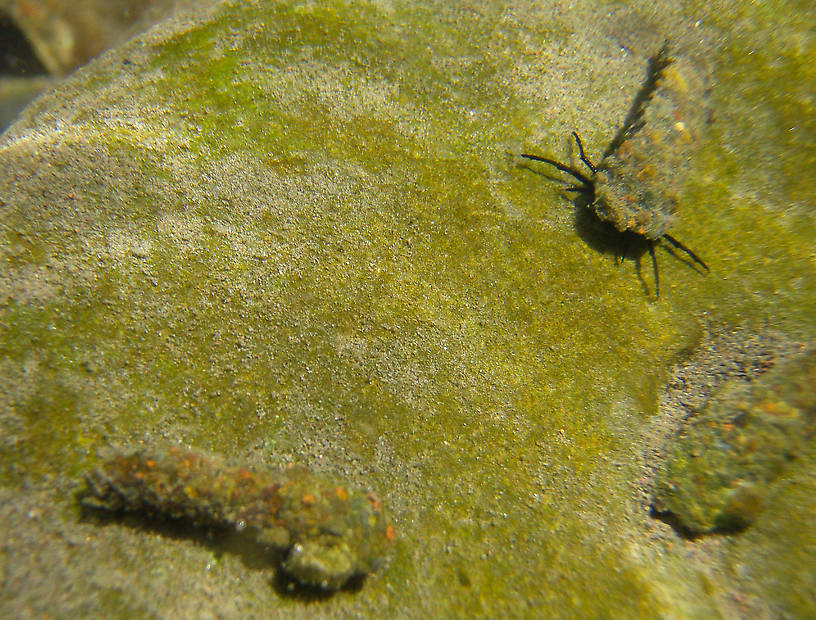Blog & Latest Updates
Fly Fishing Articles
Insects by Common Name


Caddisfly Family Limnephilidae (Northern Caddisflies)
Taxonomic Navigation -?-
Kingdom
Animalia (Animals)
» Phylum
Arthropoda (Arthropods)
» Class
Insecta (Insects)
» Order
Trichoptera (Caddisflies)
» Family Limnephilidae (Northern Caddisflies)
32 genera aren't included.
Common Names
| Match | Common Name |
| Northern Caddisflies | |
| Giant Sedges |
Limnephilidae contains so many species that it is difficult to generalize about them all. LaFontaine commented on the task in Caddisflies:
The fact that fly fishermen need broad principles of biology, not a collection of exceptions, makes it difficult to handle this family.
I recommend learning which genera or species are prevalent in your area and studying them specifically.
Where & When
There are species in this family for any type of water, but it's worth nothing that many species or genera exist mostly or entirely in lakes and ponds.
Many species enter diapause (Diapause: A state of complete dormancy deeper even than hibernation. While in diapause, an organism does not move around, eat, or even grow. Some caddisfly larvae enter diapause for a few weeks to several months. Some species of microscopic zooplankton can enter diapause for several hundred years.) during the summer to coordinate their fall emergence so that all individuals emerge within a few weeks and have no trouble locating mates.
Hatching Behavior
Limnephilidae pupae may emerge on the surface or by crawling out onto rocks and the shore, depending on species and sometimes varying within a single species.
Egg-Laying Behavior
Many Limnephilidae females lay their eggs on dry land near the water, waiting for them to be washed in by rain or taken by floods. Others dive to the bottom to lay eggs.
Larva & Pupa Biology
Diet: Algae, decaying leaves and wood, decaying animals
Shelter Type: Tube with silk on the inside and plant matter, sand, or gravel on the outside
Pictures of 28 Caddisfly Specimens in the Family Limnephilidae:
Onocosmoecus (Great Late-Summer Sedges) Caddisfly Larva View 17 Pictures
View 17 Pictures
 View 17 Pictures
View 17 PicturesCollected May 10, 2008 from the Chena River in Alaska
Added to Troutnut.com by Troutnut on April 20, 2011
Added to Troutnut.com by Troutnut on April 20, 2011
Pycnopsyche (Great Autumn Brown Sedges) Caddisfly Larva View 12 Pictures
View 12 Pictures
 View 12 Pictures
View 12 PicturesCollected April 1, 2007 from Mystery Creek #62 in New York
Added to Troutnut.com by Troutnut on April 3, 2007
Added to Troutnut.com by Troutnut on April 3, 2007
Female Dicosmoecus atripes (October Caddis) Caddisfly Adult View 6 PicturesThis specimen is 26 mm.
View 6 PicturesThis specimen is 26 mm.
- Entoman
 View 6 PicturesThis specimen is 26 mm.
View 6 PicturesThis specimen is 26 mm.- Entoman
Collected September 27, 2013 from the St. Joe River in Idaho
Added to Troutnut.com by Entoman on September 29, 2013
Added to Troutnut.com by Entoman on September 29, 2013
1 Underwater Picture of Limnephilidae Caddisflies:

These are probably 3rd instar larvae of Dicosmoecus gilvipes. The 4th instar larvae will be the round case made of sand grains.
In this picture: Caddisfly Species Dicosmoecus gilvipes (October Caddis).
In this picture: Caddisfly Species Dicosmoecus gilvipes (October Caddis).
StateWashington
LocationTouchet River
Date TakenJun 23, 2011
Date AddedJun 27, 2011
AuthorBnewell
Camerau770SW,S770SW
Recent Discussions of Limnephilidae
october caddis
Posted by Amosg on Oct 6, 2011 in the genus Dicosmoecus
In Alberta they exist in very small numbers but are not important to fishermen--Amos
ReplyYou Western anglers - any experience with the Giant Orange Sedges? 7 Replies »Posted by Troutnut on Jul 29, 2006 in the genus Dicosmoecus
Last reply on Jan 7, 2009 by Dgracia
This seems to be a very important insect for which I have no experience and few sources. I want to be sure that my writeup is accurate and fairly complete. Do any of you who fish out west know any details I've left out?
ReplyOctober Caddis 19 Replies »Posted by Taxon on Jul 29, 2006 in the genus Dicosmoecus
Last reply on Oct 24, 2008 by Jack_k
Jason-
In the Pacific NW, Dicosmoecus are generally referred to as either October Caddis or Fall Caddis. The field guide I generally recommend for western fly fishers is Hatch Guide For Western Streams by Jim Schollmeyer. This is what he has to say about Dicosmoecus pupae, and I believe it clarifies any ambiguity of the passage you quoted from Caddisflies:
ReplyGreat Autumn Brown Sedges on Potomac River 3 Replies »In the Pacific NW, Dicosmoecus are generally referred to as either October Caddis or Fall Caddis. The field guide I generally recommend for western fly fishers is Hatch Guide For Western Streams by Jim Schollmeyer. This is what he has to say about Dicosmoecus pupae, and I believe it clarifies any ambiguity of the passage you quoted from Caddisflies:
In the early or mid summer, the larvae reach maturity and move from the faster currents to the slower flows that are generally found along the margins of the stream. Then they attach their cases to the rocks, seal themselves inside, and begin pupation. This transformation takes about two months. When the pupae are ready to emerge anytime between late afternoon and dark, they chew open the front of their cases and swim or crawl to the surface. The ones that find exposed rocks cling to them close to or just above the waterline; their pupal shucks split open and the adults emerge. Larvae that took refuge and pupated behind unexposed mid-stream rocks pupate and emerge in the open water. Most pupae emerge from waters that are too shallow or too exposed for trout. Any pupae that emerge in deep or open waters are vulnerable as they swim to shore or the surface.
Posted by BrettB on Oct 2, 2008 in the genus Pycnopsyche
Last reply on Oct 3, 2008 by GONZO
Came in to work today and noted several large Autumn sedges on doors facing river(18mm wing-to-head and 34mm total w/ antennae). Though more brownish-rusty than I remember them being, I'm relatively certain it is a Pycnopsyche due to the size, timing and dark markings near the rear mid-wing (sort of looks like a yin-yang symbol). Does anyone know of a good emerger fly for this hatch? I'm assuming it emerges in the evening through early morning. I may tie up some size 8 rusty elk hair caddis for adult imitations. Big bugs!
ReplyApataniidae? 3 Replies »I believe the genus Apatania is in its own family--Apataniidae. Also, because not all Limnephilidae are "giants," the most frequently used common name for this family is "Northern Caddisflies."
ReplyThere are 2 more topics.
Your Thoughts On Limnephilidae:
Top 10 Fly Hatches
Top Gift Shop Designs
Eat mayflies.
Top Insect Specimens
Miscellaneous Sites
Troutnut.com is copyright © 2004-2024 Jason
Neuswanger (email Jason). See my FAQ for information about use of my images.
 privacy policy
privacy policy
